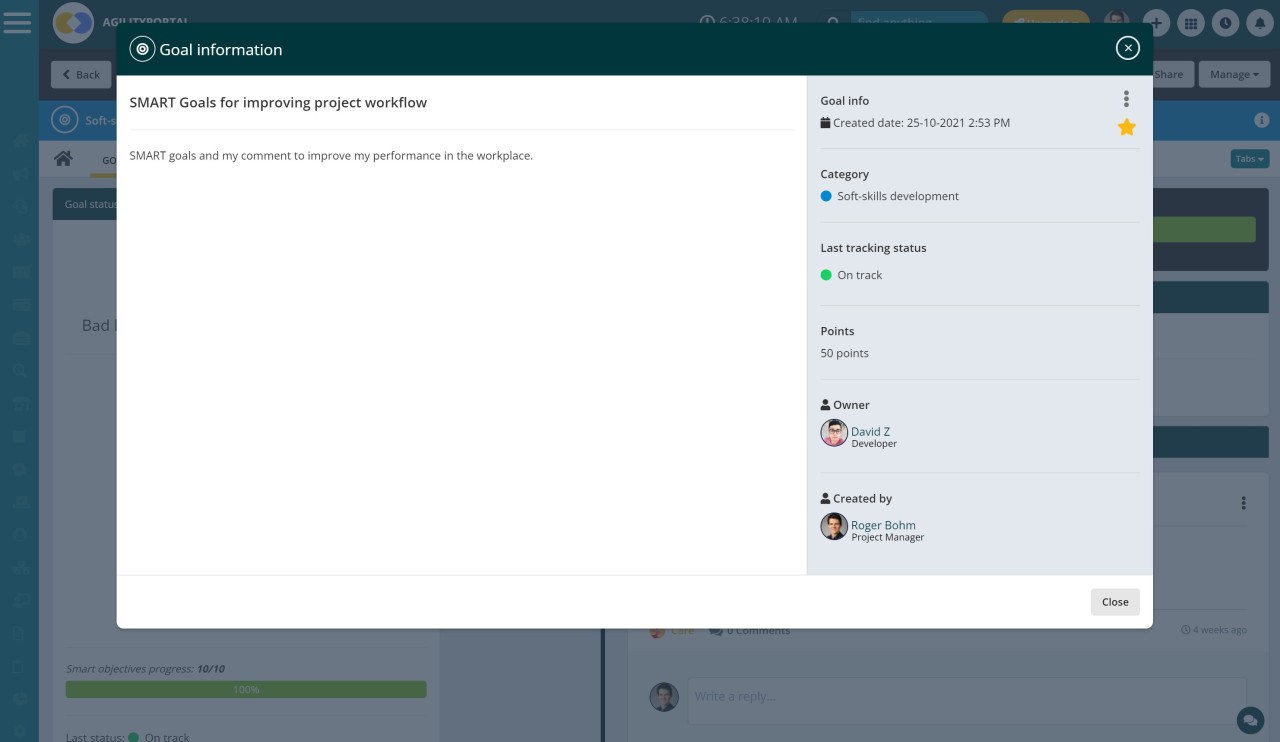Insight Blog
Agility’s perspectives on transforming the employee's experience throughout remote transformation using connected enterprise tools.
8 minutes reading time
(1646 words)
A framework for employee performance goals
SMART goals are meant to address all of your major job responsibilities. Remember, goals are intended to focus attention and resources on what is most important so that you can be successful in achieving your priorities
Goal-setting is a critical component of employee motivation, according to every leader and management you speak with. When you set attainable goals for your staff, they look forward to achieving them and are more motivated to do so. They strive to push themselves to do the minor activities that lead to the ultimate objective, especially if it is motivated by rewards and recognition. The best technique to encourage an employee in the workplace is yet to be determined, but the majority of managers consider goal setting to be a motivational feature that encourages employees to complete tasks.
All of your employees are an important part of your organization as they have a distinct set of skills that you value. Remember that to be a part of the organization, and the personnel had to go through a rigorous hiring process. It is critical to recognize that the goals you set must be relevant and practical in order to drive your employees to perform at their best.
Most managers make the first and greatest mistake when it comes to goal-setting: they set unrealistic expectations. An unattainable objective just adds to your stress level. A difficult-to-achieve goal motivates employees to work even harder. But it's an attainable aim. When an employee fails to meet his or her objectives, he or she becomes demotivated and loses their drive. Setting reasonable and achievable goals is critical to ensuring that the employee's ambition does not wane as a result of increased stress. Furthermore, many managers fail to recognize their employees' strengths and talents; could you ask French linguists to create software?
Giving useful feedback is a difficult skill to acquire. However, the good news is that there is always room for improvement. It could be useful to categorize feedback into two categories: encouraging and corrective. Reinforcing feedback is when you give feedback on activities you want people to keep doing and do more of. Corrective feedback is when you propose items that you think someone should do less of or cease doing.
Making sure You Succeed by setting realistic goals for employees
Every little objective you establish for your employee must be well aligned with the main goal of the organization if you want your employee's performance to be extremely effective. When an employee's activities are linked with the organization's ultimate purpose, and their performance helps to organizational growth, they will perform efficiently and effectively.
Provides supervisors and employees with clear direction. Provide opportunities for employees to communicate effectively and create a frame of reference. Focus on the company's short- and long-term objectives.
Assist in performance evaluations by serving as a reference guideline. Increase staff engagement by analyzing the factors that are causing problems. Providing a perfect environment for creating a sense of fulfillment; signifies success for people who are nearing their objectives. Assist employees in understanding the bosses' expectations.
Supervisors can assist employees in reaching their objectives by defining a clear performance target that is realistic and relevant to the person and their abilities. Here are some suggestions for setting goals that are both achievable and meaningful to the employee.
SMART goals
SMART goals are used in employee evaluations to improve performance management. They stand for "specific," "measurable," "achievable," "relevant," and "timely." SMART goals are a step-by-step method for forming and achieving objectives that can be used in conjunction with evaluations and performance reviews.
Your goals need to be specific; for example, what does it mean to "present"? Is creating webinar content a part of this objective? What period of time is considered longer than expected?
The performance goal should also state how the goal will be measured once it is completed. Quality and cost-effectiveness are two popular approaches to assess a company's product.
Employees should have power over the outcome of a performance goal. External influences should not be considered when determining whether a goal has been met or not. It would be unjust, for example, to ignore the lack of major data while evaluating trends in our example of a report updating as a goal.
Time is another constraint in achieving an organization's goals, so you need to do everything within a given time.
- Who – Consider who needs to be involved to achieve the goal (this is especially important when you're working on a group project).
- What – Think about exactly what you are trying to accomplish and don't be afraid to get very detailed.
- When – You'll get more specific about this question under the "time-bound" section of defining SMART goals, but you should at least set a time frame.
- Where – This question may not always apply, especially if you're setting personal goals, but if there's a location or relevant event, identify it here.
- Which – Determine any related obstacles or requirements. This question can be beneficial in deciding if your goal is realistic. For example, if the goal is to open a baking business, but you've never baked anything before, that might be an issue. As a result, you may refine the specifics of the goal to be "Learn how to bake in order to open a baking business."
- Why – What is the reason for the goal? When it comes to using this method for employees, the answer will likely be along the lines of company advancement or career development.
Examples of employee performance goals
Goals associated with collaboration
These are objectives aimed at assisting a colleague in reaching their objectives in order to promote collaboration. It affects motivation, productivity, performance, and resilience in a direct way. For example, an employee should help Andy to complete the sales target by June.
Development goals for employees
In a competitive market, these objectives help employees stay current and relevant. For instance, by the end of the year, you should have completed the Search Engine Optimization course and be ready to begin on-site SEO training in the first week of January.
Goals related to self-management
To be able to adapt, produce results, be accountable, and have decision-making powers are all part of self-management goals. In addition, an employee must also be able to focus and manage his time. They are developing these abilities aids in the achievement of professional objectives. Implement excellent time management to be able to complete tasks within the allotted time.
Goals to manage people
A manager's people management abilities demonstrate that you are a team player with great communication skills and the capacity to motivate others, whether you are an employee or a manager. It also supports cross-functional skill development goals, allowing you to collaborate with various departments inside the company.
Goals related to virtual communication
The utilization of numerous communication apps, collaborative places, and remote work options has all been made possible by technological innovation. Communication channels are continuously changing, therefore knowing how to use them is crucial.
Employee motivation will be determined by how goals are set, and employee performance will be determined by how goals are set. According to industry leaders, Objectives and Key Results is the most well-known goal management and execution methodology for defining goals. This framework guarantees that the entire organization is aligned and executes with agility to achieve strategic and tactical goals, in addition to goal planning. It provides a thorough framework for leaders to create their goals jointly, cascade them to their teams, monitor progress, conduct conversations with their teams, recognize their hard work, and finally reflect and reset goals by the end of the quarter.
How can you improve employee performance reviews?
The annual performance evaluation is frequently chastised. However, it's vital to understand that there are two sorts of employee performance evaluations: one that looks backward and seeks to understand a person's performance throughout time, and the other that looks forward and tries to understand a person's performance in the present. Another is more forward-looking, focusing on user feedback to improve an employee's future performance. These are two distinct processes with opposing objectives.
When it comes to employee performance reports, words count a lot. During an evaluation, it's critical to utilize the correct performance review terms to ensure that the feedback is clear, compassionate, and actionable. The last thing you want to do is make statements to your staff that is misunderstood or don't provide them with a clear path forward.
Because performance reviews need vulnerability on the part of both employees and managers, it's critical that the two sides' relationship is established on trust and transparency. While this may seem self-evident, research has revealed that manager capability is one of the most significant stumbling obstacles for businesses. That is why businesses should invest in leadership development, particularly in three areas: coaching and removing barriers.
The use of OKR
The Objectives and Key Results (OKR) framework originated in the 1980s, but Google popularized it as a management strategy in 1999. Since then, it has become extensively used as a method for people and teams to determine strategy and goals over a set period of time.
At the end of a work period, OKRs can be used to track progress and measure performance three times a year or just at the end of a year.
Conclusion
Given the examples of measurable objectives for employees given above, any company that follows best practices in goal-setting for its employees will grow. These objectives are an important aspect of an employee's success that has an impact on the company. Goal-setting has numerous advantages for both the organization and the employee. Employee efficiency, productivity, and development are influenced by the duties and goals. Setting unreasonable and unnecessary goals might lead to employee churn and stress. It may have an impact on the company's overall growth.
Categories
Blog
(2588)
Business Management
(318)
Employee Engagement
(204)
Digital Transformation
(172)
Intranets
(119)
Growth
(117)
Remote Work
(61)
Sales
(48)
Collaboration
(37)
Culture
(29)
Project management
(29)
Customer Experience
(26)
Knowledge Management
(21)
Leadership
(20)
Comparisons
(5)
Ready to learn more? 👍
One platform to optimize, manage and track all of your teams. Your new digital workplace is a click away. 🚀
Free for 14 days, no credit card required.
















